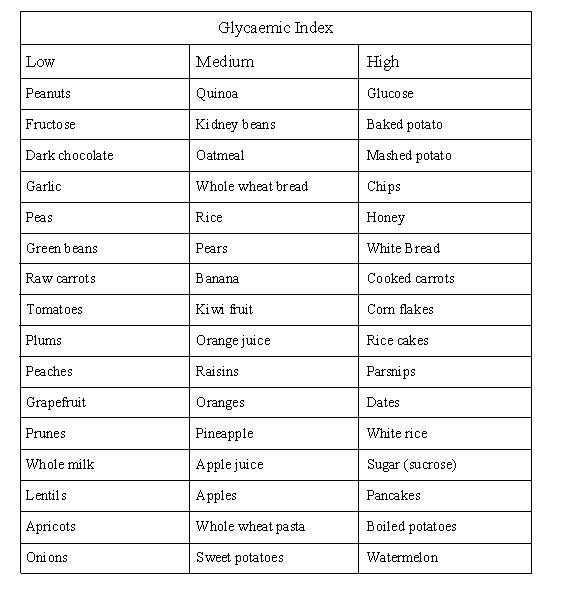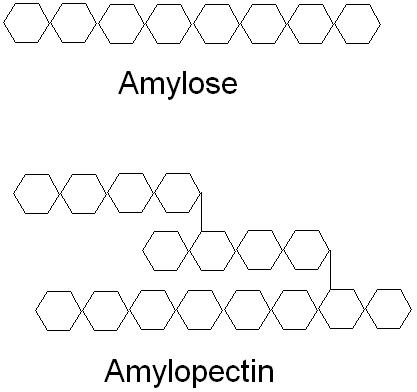Carbohydrates are biomolecules made up of carbon, hydrogen and oxygen, which humans use as a source of energy. Glucose is a six carbon molecule that makes up the majority of dietary carbohydrate content (figure 1). Glucose is often present in foods as single molecules called monosaccharides. If glucose bonds to one other monosaccharide with a glycosidic bond a disaccharide forms. For example, glucose bound to fructose forms the disaccharide sucrose; and two molecules of glucose bound together form the disaccharide maltose. Monosaccharide and disaccharides are commonly called sugars and tend to be found in fruits. Glucose can also form longer chains called polysaccharides. Polysaccharides can be thousands of glucose units long and are commonly referred to as starch. Starch is present in our diets mainly in grains, cereals and root crops.
 Figure 1. The Molecular Structure of D-alpha Glucose
Figure 1. The Molecular Structure of D-alpha Glucose
When carbohydrates are eaten, digestion to individual glucose units is accomplished by enzyme hydrolysis, followed by absorption through the enterocytes of the gut. As glucose enters the circulation, blood sugar levels rise and in response the hormone insulin is released from the pancreas. Insulin activates glucose transporters on cells, which allow movement of the glucose into the cells, lowering blood glucose levels. Carbohydrates vary in the speed that they are digested and enter the blood, and therefore different carbohydrates have different effects on blood sugar and insulin. Carbohydrates are rated for their speed of entry to the blood on a chart called the glycaemic index (figure 2). The faster a carbohydrate food enters the blood the higher its glycaemic index. There are three main reasons that carbohydrates enter the blood at different rates and they are all related to digestion.
 Figure 2. The glycaemic index of various commonly consumed foods.
Figure 2. The glycaemic index of various commonly consumed foods.
The two polysaccharides found in starchy foods are called amylose and amylopectin (figure 3). Amylose is a straight chain of glucose units and amylopectin is a highly branched molecule. Digestion of both of these types of starch requires digestive enzymes, that hydrolyse the glycosidic bonds between glucose units and slowly reduce the molecules to monosaccharides. Because amylose is a straight chain and the enzymes can only work at the ends, it takes along time for the digestive process to completely disassemble the amylose chain. However, the large number of branch points make the digestion of amylopectin much quicker. Any food with high ratio of amylopectin to amylose will therefore have a higher glycaemic index. In addition, the amylose and amylopectin chain length and starch granules size can also dictate digestion speed.
Figure 3. The polysaccharides amylose and amylopectin
Food also contains indigestible carbohydrate components commonly referred to as fibre. Just like amylose and amylopectin, this carbohydrates is made up of long chains of glucose units bonded together by glycosidic bonds. However, these bond are not in the same locations on the glucose units as they are in the amylose and amylopectin and so they require a different set of digestive enzymes to hydrolyse them. Humans do not possess the necessary enzymes and so the glucose within dietary fibre in not available for energy. Water soluble fibre can absorb water and form gels within the gut that delay the emptying of the food from the stomach to the intestine where absorption occurs. Therefore foods with higher contents of water soluble fibre are able to delay digestion and reduce the glycaemic index of foods.
As well as the amylose, amylopectin and fibre content of the foods, high levels of protein are also able to reduce the glycaemic response to food. Consuming protein foods along with carbohydrates decreases blood glucose response because protein slows the speed of digestion considerably. Proteins are highly complex molecules made up of chains of amino acids that are joined by peptide bonds. Protein digestion begins in the stomach with the addition of hydrochloric acid and the digestive enzyme pepsin. Food is prevented from leaving the stomach until the protein is broken down to smaller chain peptides. Once peptides are detected the gastric sphincter opens and the food begins to empty slowly into the small intestine for further digestion and absorption. Protein is therefore the main rate limiting step in digestion because it controls gastric emptying.
A study published in the American Journal of Clinical Nutrition in 20081 investigated the effect of glycaemic rating on the health outcomes for particular diseases. Using statistical methods they reviewed previous intervention trials to see if the glycaemic index of the foods people consumed was related to the health of the subjects. Data they presented from previous studies demonstrated that consumption of a low glycaemic diet resulted in improvements in blood sugar levels and improved insulin sensitivity. Their research also demonstrated that a reduction in glycaemic load (the glycaemic index related to portion size) of just 17 grams per day resulted in reductions in body weight and blood triglyceride levels in subjects. The authors concluded that consumption of reduced glycaemic foods resulted in favourable changes in the health markers examined.
Eating low glycaemic index meals would appear to be beneficial to health, and this might explain why dietary fibre protects from disease and obesity. Those who are overweight and wish to reduce their body fat may benefit from decreasing the total carbohydrate content of the diet and increasing total protein intake; as already discussed in a previous article (here). Because natural sugars in fruit tend to be present along with fibre and other nutrients, they should still be part of a healthy diet. However, processed and refined food with added sugar should be avoided because of their deleterious impact on insulin sensitivity. Because chromium is essential to the correct functioning of the insulin receptor, adequate intake is essential in order to maintain blood sugar within the homeostatic parameters required for healthy functioning of cells.
RdB

